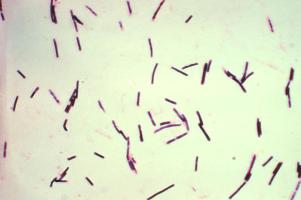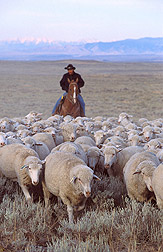Ovis aries: More about Mary's Little Lamb
Other Organisms Enjoying Sheep
The domestication of sheep by humans began about 11,000 years ago. Everything from the horns to the meaty insides was made good use of by the early humans. Today, sheep play a significant role in the economy as well.
·Sheep
pelts and wool can be made into clothes and
carpet.
·
Lamb and mutton are both types
of meat derived
from sheep.
· People drink sheep milk or use it to make cheese.
· In
the past, sheep horns were made into knife
handles, spoons, and
even hair
combs.
·
More recently, humans have been using sheep in experiments to
further knowledge in the fields of health and
science.

·
Sheep
ked, also known as Melophagus ovinus, are
parasites the
size of
house flies that reside in the wool
of sheep. These parasites
suck the blood of sheep and
cause them irritation.
·
Sheep
are also known to get
lice in their wool. Unlike
sheep ked, lice
are
harder to spot because they are
much smaller. The most common
lice found in sheep
have a pale buff color.
Internal Parasites
• Bacteria: There are many types of bacteria that are mutualistic to sheep. For example, a variety of bacteria help break down food in the intestines of sheep. Sometimes conditions change and mutualistic bacteria turn parasitic in sheep.
· Fusobacterium necrophorum is a bacterium that normally resides in the digestive tract of sheep. However, when a sheep becomes infected by another bacterium called Bacteroides nodosa, the two bacteria together cause foot rot in sheep. Foot rot causes damage to the soft tissue of the foot. Sheep will often limp or fall to their knees due to the pain caused by these bacteria.
· Fusobacterium necrophorum also becomes parasitic when the bacterium Corynebacterium pyogenis finds its way into sheep. These two bacteria cause pus to develop above the hoofs of sheep.
·
Listeria monocytogenes is a bacterium that causes
a disease known as listeriosis. The bacterium makes a neurotoxin
in sheep that causes t hem to walk around in circles with their
heads to the side. Fever and drooling are other symptoms caused
by this disease.
hem to walk around in circles with their
heads to the side. Fever and drooling are other symptoms caused
by this disease.
· Clostridium perfringens is the most dreaded bacterium of the sheep. C. perfringens is one of the factors that causes the most fatalities in lambs and yearlings.
• Worms: It is almost impossible to rid a pasture completely of worms. First, sheep ingest plants that are infected with worms, introducing the worms to the sheep's digestive tract. There, the worms lay their eggs, and eventually the sheep defecate the eggs back out onto the pasture where the worms infect more plants. Sheep with worms will often get diarrhea, lose weight, become depressed, or lose their appetite. Severe worm infections pale the skin beneath a sheep's eyelid or gums due to anemia.
Predators
Who would want to harm creatures as adorable as sheep?! There are actually quite a few animals that hunt sheep. The following creatures all prey on sheep.
 · Coyotes
· Coyotes
·
Wolves
· Foxes
· Bears
·
Cougars
Previous
Click
here to stroll to more interesting sheep facts
Baaaack Home
